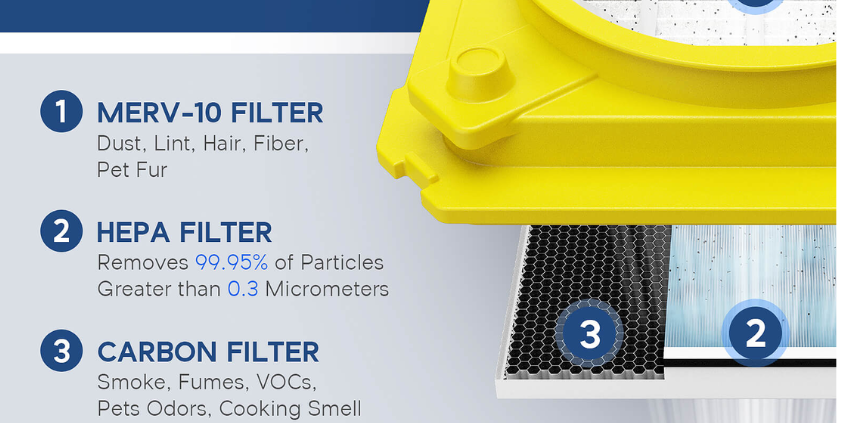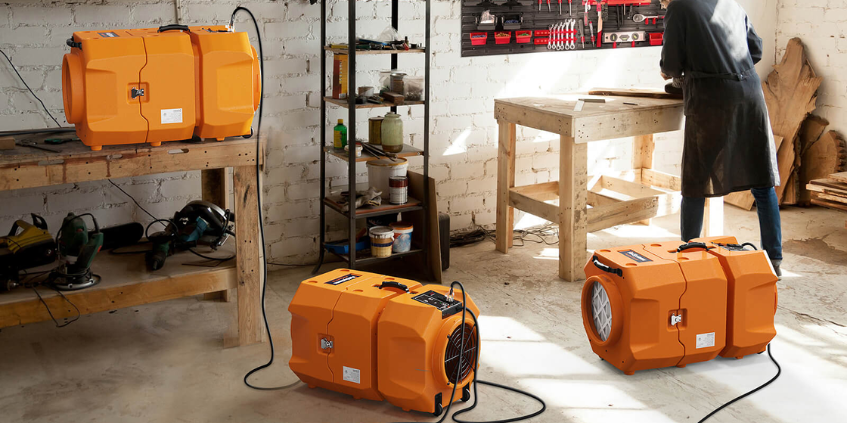Are you dealing with dust, mold, or other airborne contaminants in your home and wondering how to get them under control? Maybe you’ve heard of using negative pressure environments but aren’t quite sure how they work. If you’re considering a HEPA-filtered air scrubber or already have one, you’re on the right track to cleaner, healthier air.
In this article, we’ll break down what a negative pressure environment is, why it’s useful, and exactly how you can use your HEPA-filtered air scrubber to create one in your home. Whether you’re tackling a home renovation, cleaning up after water damage, or simply looking to improve your indoor air quality, we’ve got you covered with straightforward tips and advice.
What is Negative Pressure Environments?
A negative pressure environment creates a space where the air pressure inside is lower than the surrounding areas. This pressure difference causes air to flow inward, trapping contaminants like mold spores, dust, wood particles, or allergens inside, preventing them from spreading to other parts of your home. It’s an effective strategy for keeping indoor air clean and ensuring harmful particles stay contained during projects like home renovations, mold remediation, or flood cleanup. Additionally, negative pressure setups, combined with air filtration systems, work well in woodworking shops and garages, helping to manage wood dust, fumes, and other airborne contaminants for a safer and cleaner workspace.
What Is a HEPA-Filtered Air Scrubber?
A HEPA-filtered air scrubber is a portable device that cleans the air by pulling in dirty air, filtering out contaminants, and releasing clean air back into the environment. The key here is the HEPA (High-Efficiency Particulate Air) filter, which can capture 99.97% of particles as tiny as 0.3 microns. That means it’s incredibly effective at removing dust, mold spores, allergens, and other fine particles from the air.
When you use a HEPA-filtered air scrubber like the AlorAir PureAiro HEPA Pro 770, or the AlorAir PureAiro HEPA Pro 970 in a negative pressure setup, it doesn’t just filter the air, it helps keep the contaminated air contained, making sure it doesn’t spread to other areas. That’s why these scrubbers are often used in situations where air quality is critical, like after a fire, during mold remediation, or in chemical spills, where airborne particles can pose serious health risks.

How to Create a Negative Pressure Environment?
If you’re looking to create a negative pressure environment using a HEPA-filtered air scrubber, here’s how to get started:
Choose the Right Location
Start by picking the right spot where negative pressure is needed. Ideally, it should be a space you can fully enclose or seal off, like a single room or a sectioned-off area. Smaller spaces are easier to manage, but if you’re working in a large room, you can break it into smaller sections using temporary barriers. Be sure to consider the type of contaminants you’re dealing with when deciding on the size and location.
Seal Off the Area
Once you’ve chosen your space, make sure it’s sealed tight to keep air from leaking out. Close all windows, doors, and vents, and use plastic sheeting and duct tape to cover any gaps or openings. Pay extra attention to cracks, outlets, or pipe openings—anywhere air could escape. The better you seal the area, the more effective your negative pressure setup will be. For added strength, using double layers of plastic sheeting can help, and if you need frequent access, zippered entryways are a convenient option that won’t compromise the seal.
Set Up the HEPA-Filtered Air Scrubber
Next, position the HEPA-filtered air scrubber inside the sealed area. Make sure it’s easy to access for filter changes and maintenance and connect an exhaust duct to vent the clean air outside. Set the scrubber to the right speed to keep airflow steady without overwhelming the space. Place it near the center or close to the contamination source for the best airflow, and if possible, elevate it off the ground to help distribute clean air more evenly.
Direct the Exhaust Air to an Outside Location
To create the negative pressure effect, you’ll need to vent the filtered air outside. Run the exhaust duct through a window, door, or another outlet, making sure it’s sealed tightly at both ends to prevent leaks. Direct the exhaust away from high-traffic areas to avoid exposing people to contaminants. Make sure the exhaust outlet is far enough from any air intakes or building openings so you don’t accidentally bring contaminants back inside.
Monitoring and Maintaining the Negative Pressure Environment
Keeping a negative pressure environment working smoothly requires some regular monitoring and maintenance:
Monitor the Air Pressure: To make sure the negative pressure stays in place, use tools like differential pressure monitors, manometers, or even smoke sticks to check the pressure. These will help you ensure that the air pressure inside remains lower than outside. Typically, you’ll want to maintain a pressure difference of at least -0.02 inches of water column (W.C.) for the setup to work effectively.
Check and Replace Filters Regularly: Over time, your HEPA filters will collect dust and debris, which can reduce the scrubber’s performance. Be sure to replace the filters as recommended by the manufacturer or if you notice the airflow slowing down. Skipping filter changes can lower the scrubber’s efficiency and make it harder to maintain negative pressure.
Troubleshoot Any Issues: If you notice that the negative pressure has been lost, check for air leaks or equipment malfunctions. Make sure all seals are still intact, and the air scrubber is working properly. Also, inspect the exhaust duct for any blockages or leaks that could be messing with the airflow.

Where Homeowners Can Benefit from Negative Pressure Environments
Negative pressure environments aren’t just for hospitals or construction sites—they can make a big difference in your home, too. Here are a few common scenarios where creating pressure with a HEPA-filtered air scrubber can help:
Mold Remediation: Helps prevent mold spores from spreading during cleanup, protecting the rest of your home. Both the Environmental Protection Agency (EPA) and the Centers for Disease Control and Prevention (CDC) recommend using HEPA filters during mold remediation for their ability to capture harmful particles, including mold spores and other airborne contaminants.
Home Renovations: Whether you’re tearing down walls or sanding floors, renovations often stir up dust and debris. Using a HEPA-filtered air scrubber in a sealed-off area can trap airborne dust, keeping the rest of your home cleaner and healthier.
Post-Flood Cleanup: After water damage, mold and mildew can quickly become a problem. Setting up negative pressure in affected areas helps contain moisture and prevents contaminants from spreading while you dry out and repair the space.
Allergy Control: If seasonal allergies are making life difficult, creating a negative pressure environment can help keep pollen and other allergens from entering specific rooms, like bedrooms, providing a cleaner space to breathe.
DIY Asbestos or Lead Paint Removal: If you’re tackling small projects like removing old insulation or lead paint, negative pressure can help keep harmful particles from spreading to the rest of your home, protecting your family during the process.
Using HEPA-filtered air scrubbers in these situations ensures your home’s air quality stays high, minimizing exposure to harmful particles and making your living space safer.
Take Charge of Your Air Quality
Creating a negative pressure environment with a HEPA-filtered air scrubber is an effective way to contain contaminants and improve air quality in your home. By choosing the right location, sealing the area properly, setting up your air scrubber, and venting air outside, you can easily establish and maintain a safe, controlled environment. Don’t forget, regular monitoring and maintenance are key to keeping things running smoothly.
For high-quality HEPA-filtered air scrubbers and ventilation solutions, check out the selection at AlorAir.com. With reliable products designed to keep your space safe and clean, we have everything you need to manage air quality in any setting.










.jpg)
.jpg)

.jpg)
.jpg)
.HDi90.png)
.HD90.png)









.jpg)
.jpg)
.jpg)





.jpg)
.jpg)


.jpg)








.jpg)
.jpg)








.jpg)
.jpg)























.jpg)
.jpg)
.jpg)





.jpg)
.jpg)
















-.jpg)
.jpg)

.jpg)
.jpg)



























 Exclusive offers
promotions
Exclusive offers
promotions

